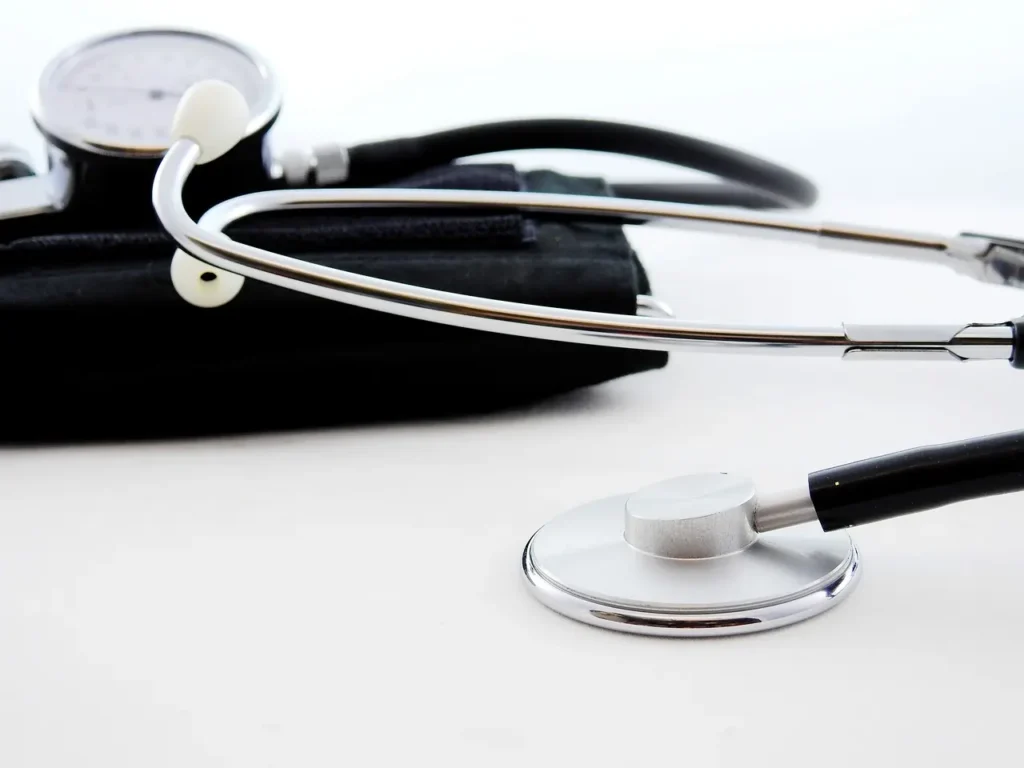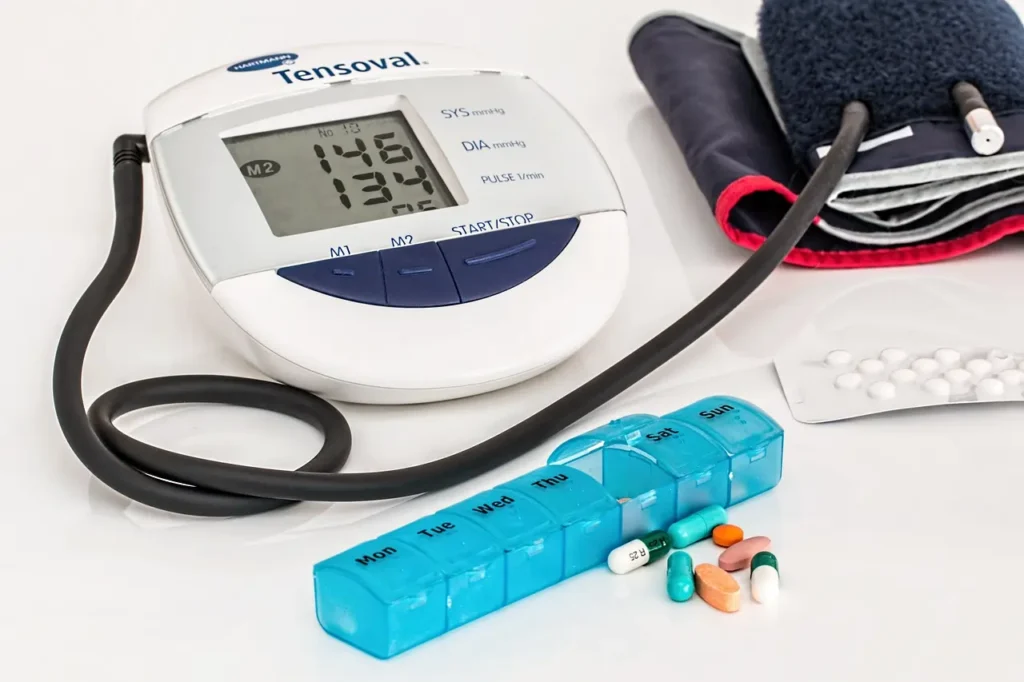Blood pressure refers to the force of blood against the walls of arteries as it circulates through the body. It is expressed as two numbers, the systolic pressure (top number) and diastolic pressure (bottom number). Systolic pressure measures the force of blood when the heart beats, while diastolic pressure measures the force of blood when the heart is at rest between beats. Blood pressure is an important measure of overall cardiovascular health, as high or low blood pressure can indicate an increased risk of heart disease, stroke, and other health problems.
How is Blood Pressure Measured
To measure blood pressure, a healthcare professional typically uses a device called a sphygmomanometer. The healthcare professional will wrap an inflatable cuff around the upper arm and then pump air into the cuff to temporarily stop blood flow. They will then slowly release the air while listening to the pulse in the artery using a stethoscope. The first sound that is heard indicates the systolic pressure, while the disappearance of the sound indicates the diastolic pressure. Digital blood pressure monitors can also be used, which automatically inflate and deflate the cuff and display the results on a screen. It is important to measure blood pressure correctly and consistently, as factors such as stress, physical activity, and certain medications can affect blood pressure readings.

The Two Numbers: Systolic and Diastolic Pressure
Blood pressure is measured using two numbers: systolic pressure and diastolic pressure. Systolic pressure is the top number and represents the pressure in the arteries when the heart beats and pumps blood. Diastolic pressure is the bottom number and represents the pressure in the arteries when the heart is at rest between beats. Blood pressure is measured in millimeters of mercury (mmHg) and is expressed as systolic pressure over diastolic pressure, such as “120 over 80” mmHg. Both numbers are important in determining overall cardiovascular health, as high systolic or diastolic pressure can indicate an increased risk of heart disease, stroke, and other health problems.
Normal Blood Pressure Ranges
The normal range for blood pressure varies based on age, gender, and other factors. However, generally speaking, a healthy blood pressure range is considered to be below 120/80 mmHg. This means that the systolic pressure should be below 120 mmHg and the diastolic pressure should be below 80 mmHg. Blood pressure that falls between 120/80 mmHg and 129/84 mmHg is considered to be elevated, while blood pressure that consistently measures at or above 130/80 mmHg is considered high and may require medical attention. Maintaining a healthy blood pressure range through diet, exercise, and lifestyle changes can help prevent cardiovascular disease and other health problems.
Factors That Affect Blood Pressure
Several factors can affect blood pressure, including:
- Age: Blood pressure tends to increase as we age.
- Gender: Men are more likely to have higher blood pressure than women until age 64, after which women are more likely to have higher blood pressure.
- Weight: Being overweight or obese increases the risk of high blood pressure.
- Diet: A diet high in sodium and low in potassium can increase blood pressure.
- Physical activity: Regular exercise can help lower blood pressure.
- Smoking: Smoking can damage the blood vessels and increase the risk of high blood pressure.
- Stress: Chronic stress can contribute to high blood pressure.
- Certain medications: Certain medications, such as decongestants, can raise blood pressure.
- Family history: A family history of high blood pressure increases the risk of developing high blood pressure.
Why Monitoring Blood Pressure is Important
Monitoring blood pressure is important because high or low blood pressure can indicate an increased risk of several health problems, including heart disease, stroke, kidney disease, and vision loss. High blood pressure, also known as hypertension, is often called the “silent killer” because it may not cause symptoms until it reaches dangerous levels. Regular monitoring of blood pressure can help individuals detect and manage high blood pressure early, reducing the risk of serious complications. Similarly, low blood pressure, or hypotension, can cause dizziness, fainting, and other symptoms that can be dangerous in certain situations. Monitoring blood pressure can also help individuals evaluate the effectiveness of lifestyle changes or medications to control blood pressure and make adjustments as needed.
Understanding High Blood Pressure (Hypertension)
High blood pressure, or hypertension, is a condition in which the force of blood against the artery walls is consistently too high. This can cause damage to the blood vessels and increase the risk of heart disease, stroke, kidney disease, and other health problems. There are two types of hypertension: primary (essential) hypertension and secondary hypertension. Primary hypertension is the most common type and is usually caused by a combination of factors, including genetics, lifestyle, and environmental factors. Secondary hypertension is caused by an underlying medical condition, such as kidney disease or sleep apnea.
Symptoms of high blood pressure are often silent, which is why it is important to regularly monitor blood pressure. Risk factors for developing high blood pressure include age, gender, family history, being overweight or obese, eating a diet high in sodium and low in potassium, physical inactivity, smoking, chronic stress, and certain medical conditions. Treatment for hypertension often involves lifestyle changes such as a healthy diet, regular exercise, and stress management techniques. Medications may also be prescribed to help lower blood pressure.

Understanding Low Blood Pressure (Hypotension)
Low blood pressure, or hypotension, is a condition in which the force of blood against the artery walls is consistently too low. This can cause inadequate blood flow to the organs and tissues, leading to symptoms such as dizziness, fainting, blurred vision, and fatigue. Hypotension is generally defined as a reading of 90/60 mmHg or lower.
Several factors can cause hypotension, including dehydration, heart problems, endocrine problems, blood loss, and certain medications. Some individuals may also have naturally low blood pressure, which is not typically a cause for concern unless it causes symptoms.
Treatment for hypotension depends on the underlying cause. In some cases, simply increasing fluid and salt intake can help raise blood pressure. In other cases, medications may be needed to treat an underlying condition or to help raise blood pressure.
Lifestyle Changes to Maintain Healthy Blood Pressure
Here are some changes that can help:
- Eat a healthy diet: A diet that is low in sodium and high in potassium can help lower blood pressure. This means eating plenty of fruits, vegetables, whole grains, and lean protein.
- Exercise regularly: Regular physical activity can help lower blood pressure and improve overall health. Aim for at least 30 minutes of moderate-intensity exercise most days of the week.
- Maintain a healthy weight: Being overweight or obese can increase the risk of high blood pressure. Losing weight and maintaining a healthy weight can help lower blood pressure.
- Limit alcohol intake: Drinking too much alcohol can raise blood pressure. Men should aim for no more than two drinks per day, while women should aim for no more than one drink per day.
- Quit smoking: Smoking can damage the blood vessels and increase the risk of high blood pressure. Quitting smoking can help lower blood pressure and improve overall health.
- Manage stress: Chronic stress can contribute to high blood pressure. Finding healthy ways to manage stress, such as through meditation, yoga, or other relaxation techniques, can help lower blood pressure.
When to Seek Medical Help
While making lifestyle changes can help manage blood pressure, there are times when it is important to seek medical help. Here are some situations when it is important to talk to a healthcare provider:
- High blood pressure readings: If blood pressure readings consistently measure at or above 130/80 mmHg, it is important to talk to a healthcare provider about treatment options.
- Symptoms of high or low blood pressure: Symptoms such as chest pain, shortness of breath, severe headaches, blurred vision, dizziness, fainting, or confusion may indicate a serious blood pressure problem and require immediate medical attention.
- Side effects from blood pressure medications: If experiencing side effects from blood pressure medications, such as dizziness, nausea, or swelling, it is important to talk to a healthcare provider about adjusting the medication dosage or switching to a different medication.
- Pregnancy: Pregnant women should monitor blood pressure regularly, as high blood pressure during pregnancy can be dangerous for both the mother and the baby.
- Underlying medical conditions: If diagnosed with a medical condition that may affect blood pressure, such as kidney disease, diabetes, or sleep apnea, it is important to work closely with a healthcare provider to manage the condition and monitor blood pressure.
Blood Donation Map – Find a Phlebotomist Near You
Are you in need of a phlebotomist in your area? Look no further than this comprehensive Blood Donation Map. Finding a qualified phlebotomist nearby has never been easier! Whether you’re looking to donate blood or require blood work for medical purposes, this specialized map is designed to help you locate the right professionals in your vicinity. With just a few clicks, you can access the map and discover a wide range of phlebotomy services available near you.
References
- American Heart Association. Understanding Blood Pressure Readings
- Mayo Clinic. High blood pressure (hypertension)
- Centers for Disease Control and Prevention. About High Blood Pressure
- American College of Cardiology. Understanding Blood Pressure
- MedlinePlus. High Blood Pressure
- World Health Organization. Hypertension